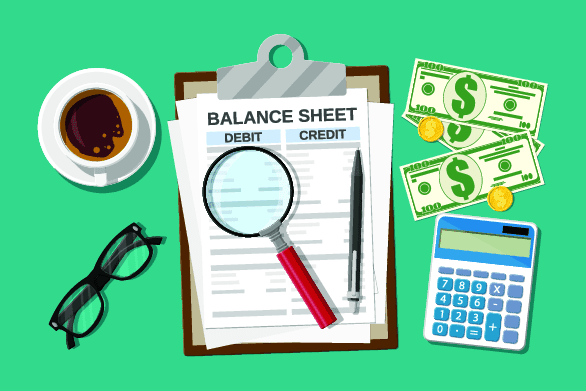There are different financial statements that every company prepares and communicates to shareholders and investors. These are tools to show a company’s financial well-being. In this article, two of the major statements – balance sheet and income statement will be explored, and their differences will be outlined.
Millions of different companies are always trying to thrive by being more prestigious, productive, and profitable. Therefore, some essential tools are used for tracking all the financial activities throughout the company. Two such tools that are key for keeping records and understanding the financial situation of a company are the balance sheet and income statement. Even though both have similar goals of tracking the financial activities in every department of a company and providing information about financial performance, they have differences too which are important to understand.
Balance Sheet
Details on a company’s assets, liabilities, and shareholder’s equity at a certain point in time can be seen in the balance sheet. Whereas some businesses utilize these statements of financial status as part of an annual report, the balance sheet is typically shared quarterly. Thus, investors and shareholders can be able to assess how well companies utilize their assets and finance their operations based on the balance sheet.
The balance sheet consists of some critical metrics: current assets, long-term assets, current liabilities, long-term liabilities, and shareholder equity. Cash and cash equivalents, short-term investments, and other assets which can be liquidated during a year are considered current assets. Marketable securities (debt, stock, bonds), inventories, and prepaid expenses are also current assets that can easily be converted to cash.
Long-term assets, on the other hand, are fixed assets such as the company’s plants, buildings, equipment, and other physical belongings. Simultaneously, long-term investments, patents, goodwill, trademarks, and copyrights also count as assets with a longer time horizon. These kinds of assets have had a beneficial influence on a company for several years.
Current and Long-Term Liabilities vs Shareholder Equity
Current liabilities are short-term debts or payments of the company which must be paid within a year or in one operating cycle. An operating cycle means a time period during which companies purchase inventory and transfer money. Examples of current liabilities are income taxes, accrued expenses, accounts payable, unearned revenues, and cash dividends payable.
Long-term liabilities seen on the balance sheet can include long-term payments that a company is obliged to make such as loans, mortgages, and payable bonds which companies have to pay typically beyond 12 months.
Shareholders’ equity depicts the net value of the company, money remaining for shareholders if a company’s total assets were converted to money and every one of its debts were repaid. All these elements are listed in the balance sheet and help to assess the financial health of companies.
Income Statement
An income statement, also called a profit and loss statement, illustrates all expenses, costs, and revenues of companies in a one-year period. Through this tool, company analysts can determine whether the company generates profit or loss. In addition, they evaluate how efficient the company strategy which is developed at the beginning of the financial period, and decide what can be done to be more profitable in the future, based on the data in the income statement. Not only internal but also external users such as investors, creditors and competitors make use of the income statement for checking the future development and profitability of the company.
Elements of the income statement are revenue, cost of goods sold (COGS), gross profit, administrative and advertising expenses, depreciation, earnings before tax (EBT), and net income. Let’s briefly disaggregate the income statement into its key elements.
Revenue can be classified as operating and non-operating which indicates the total sales made by a company. When a firm is a business that manufactures or provides goods and services, then it generates operating revenue. Non-operating income is earned by non-business activities such as interest or investment income of retailers.
COGS are all about direct costs of goods or services and include the cost of labor and materials. Company analysts have a look at the numbers on the income statement to determine how efficiently the labor and resources are utilized. When COGS increase, a decrease in revenue is unavoidable. Thus, businesses are always trying to stay cost-effective to ensure a high amount of profit. Subtract COGS from the revenue of a company and you will get gross profit or gross income. Investors are checking the gross profit of the companies for seeing to what extent the company is safe against increasing prices of materials or labor.
Another figure you can find in an income statement is gaining which results form an increased value of assets which is a type of revenue. For instance, if a company-owned land is sold at a higher price than when it was purchased it generates gains. Expenses, on the other hand, are the money spent by a firm to ensure revenue flow. It can be advertisement and administrative expenses, depreciation, or operating and non-operating expenses.
Finally, EBT and net income are two indicators in an income statement that are fairly self-explanatory. While the former is calculated as income minus all the expenses before tax, the latter results from subtracting all the costs and expenses from the total revenue.
Differences Between the Balance Sheet and Income Statement
Although they sound similar, there are several differences between the two financial statements. First of all, in terms of the time relevance of the statements, it is important to note that income statements depict an organization’s status throughout a certain period, while the balance sheet is valid at a specific point in time. Besides, the balance sheet reports assets, liabilities, and shareholder equity, whereas the income statement basically is about revenues and expenses that boil down to profit or loss in a certain period. Last but not least, management may want to use a balance sheet in order to judge whether a business has adequate liquidity to meet its debts or obligations, while they usually consult the income statement to determine the operational performance of the company and come up with corrective actions needed.
Photo: Abscent Vector/Shutterstock
You might also like:
Support us!
All your donations will be used to pay the magazine’s journalists and to support the ongoing costs of maintaining the site.
Share this post
Interested in co-operating with us?
We are open to co-operation from writers and businesses alike. You can reach us on our email at [email protected]/[email protected] and we will get back to you as quick as we can.










